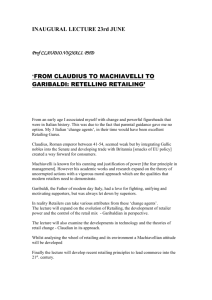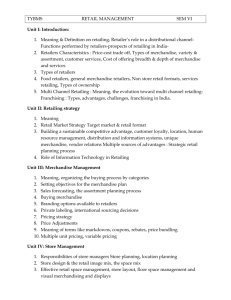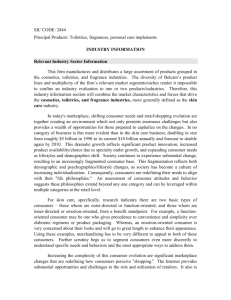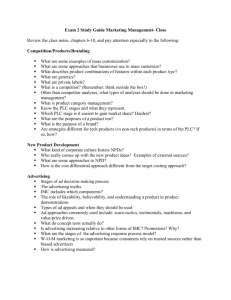Quantitative Marketing and Economics 2015 Conference Schedule
advertisement
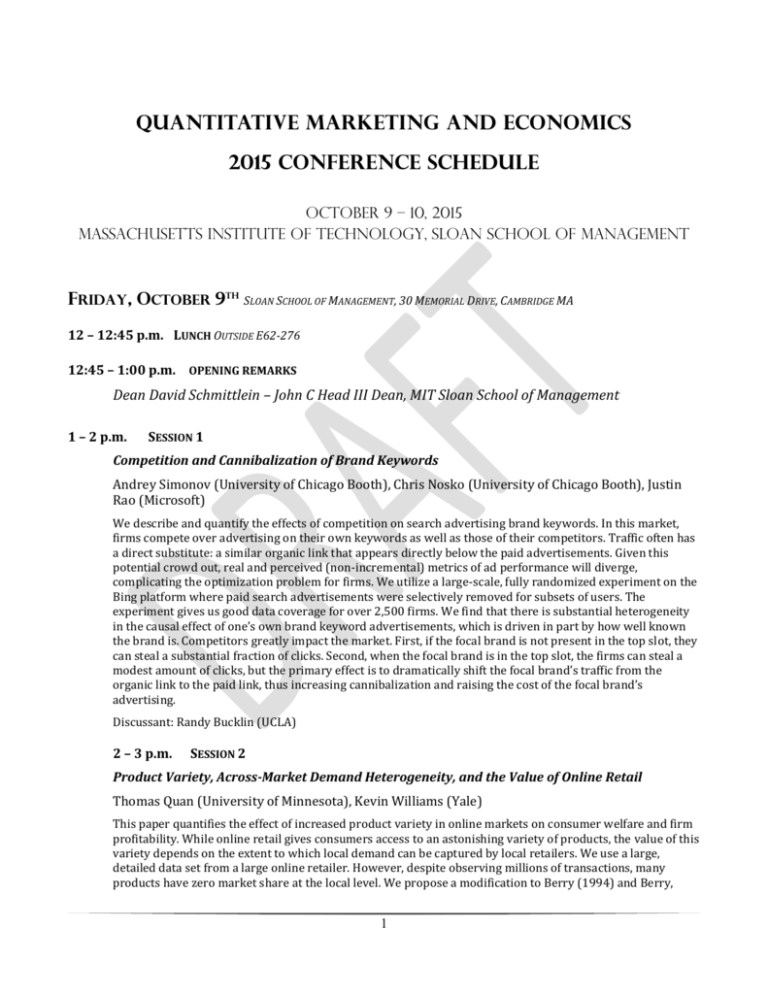
Quantitative Marketing and Economics 2015 Conference Schedule October 9 – 10, 2015 Massachusetts institute of technology, sloan school of Management FRIDAY, OCTOBER 9TH SLOAN SCHOOL OF MANAGEMENT, 30 MEMORIAL DRIVE, CAMBRIDGE MA 12 – 12:45 p.m. LUNCH OUTSIDE E62-276 12:45 – 1:00 p.m. OPENING REMARKS Dean David Schmittlein – John C Head III Dean, MIT Sloan School of Management 1 – 2 p.m. SESSION 1 Competition and Cannibalization of Brand Keywords Andrey Simonov (University of Chicago Booth), Chris Nosko (University of Chicago Booth), Justin Rao (Microsoft) We describe and quantify the effects of competition on search advertising brand keywords. In this market, firms compete over advertising on their own keywords as well as those of their competitors. Traffic often has a direct substitute: a similar organic link that appears directly below the paid advertisements. Given this potential crowd out, real and perceived (non-incremental) metrics of ad performance will diverge, complicating the optimization problem for firms. We utilize a large-scale, fully randomized experiment on the Bing platform where paid search advertisements were selectively removed for subsets of users. The experiment gives us good data coverage for over 2,500 firms. We find that there is substantial heterogeneity in the causal effect of one’s own brand keyword advertisements, which is driven in part by how well known the brand is. Competitors greatly impact the market. First, if the focal brand is not present in the top slot, they can steal a substantial fraction of clicks. Second, when the focal brand is in the top slot, the firms can steal a modest amount of clicks, but the primary effect is to dramatically shift the focal brand’s traffic from the organic link to the paid link, thus increasing cannibalization and raising the cost of the focal brand’s advertising. Discussant: Randy Bucklin (UCLA) 2 – 3 p.m. SESSION 2 Product Variety, Across-Market Demand Heterogeneity, and the Value of Online Retail Thomas Quan (University of Minnesota), Kevin Williams (Yale) This paper quantifies the effect of increased product variety in online markets on consumer welfare and firm profitability. While online retail gives consumers access to an astonishing variety of products, the value of this variety depends on the extent to which local demand can be captured by local retailers. We use a large, detailed data set from a large online retailer. However, despite observing millions of transactions, many products have zero market share at the local level. We propose a modification to Berry (1994) and Berry, 1 Levinsohn, Pakes (1995) that addresses this sampling problem. Our estimation technique is easy to implement and fits the data well. Our results indicate that products face substantial heterogeneity in demand across geographic markets which greatly mitigates the consumer gains of increasing variety when traditional brick-and-mortar retailers localize assortments. Discussant: Monic Sun (Boston Univeristy) 3 – 3:30 p.m. BREAK OUTSIDE E62-276 3:30 – 4:30 p.m. SESSION 3 Signaling in Online Credit Markets Kosuke Uetake (Yale), Kei Kawai (NYU), Ken Onishi (Singapore Management University) We study how signaling affects equilibrium outcomes and welfare in markets with adverse selection. Using data from an online credit market, we estimate a model of borrowers and lenders where low reserve interest rates can signal low default risk. Comparing a market with and without signaling relative to the benchmark case with no asymmetric information, we find that adverse selection destroys as much as 16% of total surplus, up to 95% of which can be restored with signaling. We also find the credit supply curves to be backward-bending for some markets, consistent with the prediction of Stiglitz and Weiss (1981). Discussant: Raphael Thomadsen (Washington University in St Louis) 4:30 – 5:30 p.m. SESSION 4 Channel Management and MAP: Evidence From a Quasi-Experiment Ayelet Israeli (Havard Business School) Minimum Advertised Price (MAP) is a pricing policy widely used by manufacturers to influence prices set by their downstream partners. A MAP policy imposes a lower bound on advertised prices for retailers. Retailers that advertise prices below the MAP price violate the policy and are subject to a punishment such as termination of the distribution agreement. Despite this threat, a central issue with MAP policies is compliance. Violations are often attributed to lack of monitoring by manufacturers, poor incentive mechanisms or poor partner selection. In this paper, I show that the mere fact that manufacturers monitor pricing and have a contractual threat to terminate distribution may be insufficient in achieving MAP compliance, and that the context and terms of the policy affect manufacturers’ ability to govern MAP. To demonstrate this point, I analyze the pricing, enforcement and channel management policies of a manufacturer over several years. I show that initial investments in monitoring and enforcement are ineffective in reducing MAP violations. In response, the manufacturer introduces new channel agreements and policies, which provides a quasi-experiment. These policies address the challenges of the online retail environment and credibly signal to retailers that the manufacturer is willing to enforce the MAP policy. I show that under the new channel policies, investments in monitoring and enforcement lead to a sustained 40%-­­80% reduction in violations. This effect is economically meaningful and is robust to a variety of tests and specifications. With increased compliance channel prices increase by 2% but there is no loss in volume. My analysis uncovers two key elements of successful channel policies to improve MAP compliance: customization to the online retail environment and credible monitoring and punishments. Discussant: Vineet Kumar (Yale) 6 – 7 p.m. COCKTAIL RECEPTION COMMONWEALTH MARKET AND RESTAURANT, 11 BROAD CANAL WAY, CAMBRIDGE MA 7 – 8:30 p.m. DINNER AND DICK WITTINK AWARD COMMONWEALTH MARKET AND RESTAURANT _______________________________________________________________________________ 2 SATURDAY, OCTOBER 10TH SLOAN SCHOOL OF MANAGEMENT, 30 MEMORIAL DRIVE, CAMBRIDGE MA 8 – 9 a.m. BREAKFAST OUTSIDE E62-276 9 – 10 a.m. SESSION 5 Social Learning and Solar Photovoltaic Adoption: Evidence from a Field Experiment Kenneth Gillingham (Yale), Bryan Bollinger (Duke), Hilary Staver (Environmental Economic Inc.) An extensive literature points to the importance of social interactions in influencing economic outcomes. We examine a set of natural field experiments on a rapidly expanding behavioral intervention designed to actively leverage social learning and peer interactions to promote solar photovoltaic technology in Connecticut. The “Solarize” program involves a municipality-chosen solar installer, group pricing, and an informational campaign driven by volunteer ambassadors. We show that the program is remarkably effective: a treatment effect increasing installations by 27 per municipality on average, increasing installations by over 100 percent. The program also lowers installation prices, an effect that spills over to adjacent block groups. When municipalities are chosen randomly, the treatment effect is roughly half. However, this still exceeds the treatment effect from a program run by a single installer without competitive bidding. Calculations reveal that the Solarize program is cost-effective and social welfare-improving. Survey results illuminate the mechanisms underlying our findings. Discussant: Pedro Gardette (Stanford) 10 – 11 a.m. SESSION 6 Income and Wealth Effects on Private Label Demand: Evidence From the Great Recession Günter Hitsch (University of Chicago Booth), JP Dubé (University of Chicago Booth), Peter Rossi (UCLA) We measure the causal effects of income and wealth on the demand for private-label products. Prior research suggests that these effects are large and, in particular, that private-label demand rises during recessions. Our empirical analysis is based on a comprehensive household-level transactions database matched with price information from store-level scanner data and wealth data based on local house value indices. The Great Recession provides a key source of the variation in our data, with a large and geographically diverse impact on household incomes over time. We estimate income and wealth effects using “within” variation of income and wealth at the household level. Our estimates can be interpreted as income and wealth effects consistent with a consumer demand model based on utility maximization. We establish a precisely measured negative effect of income on private-label shares. The effect of wealth is negative but not precisely measured. However, the estimated effect sizes are small, in contrast with prior academic work and industry views. An examination of the possible supply-side response to the recession shows only small changes in the relative price of national-brand and private-label products. Our estimates also reveal a large positive trend in private-label shares that predates the Great Recession. We examine some possible factors underlying this trend, but find no evidence that this trend is systematically related to specific private-label quality tiers or to the overall rate of private-label versus national-brand product introductions. Discussant: Nikhil Agarwal (MIT) 11 – 11:30 a.m. BREAK OUTSIDE E62-276 11:30 a.m. – 12:30 p.m. SESSION 7 Advertising in Vertical Relationships: An Equilibrium Model of the Automobile Industry Charles Murray (Pennsylvania State University) I estimate a model of demand for new cars and equilibrium pricing and advertising decisions of dealers and manufacturers. The estimated split of surplus between dealers and manufacturers differs from a model 3 without advertising decisions because of a public goods advertising externality within the vertical relationship. I predict firm and consumer behavior if two state franchise regulations change. First, allowing vertical integration leads to 20% lower retail prices and 30% greater advertising. Second, manufacturers are currently restricted from closing dealers, and I predict that manufacturers would substantially decrease brand advertising after dealer closures are allowed. Remaining dealers of the same brand can be worse off, even though they face less intra-brand competition. Discussant: Florian Zettelmeyer (Northwestern) 12:30 – 1:30 p.m. LUNCH OUTSIDE E62-276 1:30 – 2:30 p.m. SESSION 8 A Model of Unorganized and Organized Retailing in Emerging Economies Kinshuk Jerath (Columbia), S. Sajeesh (Baruch College), Z. John Zhang (Wharton) In recent decades, organized retailing has transformed the retailing landscape in emerging economies, where unorganized retailing has traditionally been dominant. In this paper, we build a theoretical model of unorganized and organized retailing in emerging economies by carefully modeling key characteristics of the retailing environment, the retailers, the consumers and product categories. The primary insight that we obtain is that in a competitive market comprising of only unorganized retailers, the advent of organized retailing injects efficiency into the market leading to a reduction in the number of unorganized retailers. This, in turn, makes the market less competitive. Building on this basic insight, we obtain a number of counterintuitive results. For instance: (i) the presence of organized retailing may increase the prices charged by unorganized retailers, (ii) as the consumers’ transportation cost to the unorganized retailers increases, the market share of the unorganized retailing sector may increase, (iii) as the probability of bulk consumption increases and consumers prefer to purchase more from the organized retailer, prices and profits at the organized retailer may decrease, (iv) the presence of organized retailing can lead to both consumer and social surplus being lower because consumers face higher prices at unorganized retailers and there is wastage in the economy due to bulk purchasing at organized retailers. Our model offers an explanation for certain surprising empirical observations related to retailing in emerging markets, such as why in the last few years in the Indian market the unorganized retailers who have survived the advent of organized retailing seem to be doing better. Implications from our research can provide guidance to policy makers grappling with issues related to the balanced growth of unorganized and organized retailing in emerging markets. Discussant: Alessandro Bonatti (MIT) 2:30 – 3:30 p.m. SESSION 9 Estimating the Heterogeneous Welfare Effects of Choice Architecture: An Application to the Medicare Prescription Drug Insurance Market Jonathan Ketcham (Arizona State University), Nicolai Kuminoff (Arizona State University), Christopher Powers (US Department of Health and Human Services) We develop a structural model for estimating the welfare effects of policies that alter the design of differentiated product markets when some consumers are misinformed about product characteristics. We use the model to analyze three proposals to simplify Medicare markets for prescription drug insurance: (1) reducing the number of plans, (2) providing personalized information, and (3) changing defaults so consumers are reassigned to cheaper plans. First we combine national administrative and survey data to determine which consumers appear to make informed enrollment decisions. Then we analyze the welfare effects of each proposal, using the revealed preferences of informed consumers to proxy for the concealed preferences of misinformed consumers. Results suggest that the menu reduction would harm most consumers whereas personalized information and reassignment would benefit most consumers. Each policy produces large gains and losses for small groups of consumers, but no policy changes average consumer welfare by more than 14% of average expenditures. Discussant: Andrew Ching 4 3:30 – 4 p.m. 4 – 5 p.m. BREAK OUTSIDE E62-276 SESSION 10 Informational Shocks, Off-Label Prescribing, and the Effects of Physician Detailing Brad Shapiro (University of Chicago Booth) The effects of pharmaceutical firm advertising directly to physicians using sales reps, or detailing, has been a major area of interest for both regulators and firms. As firms spend over ten billion dollars per year on detailing activities, understanding the response of such inputs is crucial to profit maximization. Regulators, on the other hand, worry that detailing might be illegally focused on off-label prescribing. In this paper, I estimate the effect of detailing in the antipsychotic category, a roughly $9 billion per year category which has been hit with over $6.5 billion in regulatory fines due to promotional practices in the past fifteen years. I estimate these effects using two studies that disseminated new information that drastically changed the nature of competition. Detailing effects are modest, but statistically significant, with the average effect of a visit being to increase prescriptions by 0.15 over the short term and 0.3 over the long term. While detailing raises both on-label and off-label prescriptions, I find evidence that it disproportionately raises on-label prescriptions. This disproportionate effect stems from the fact that detailing to physicians who primarily prescribe off-label is ineffective. Discussant: Puneet Manchanda (University of Michigan) 5

